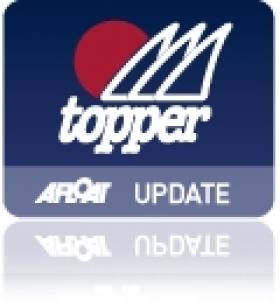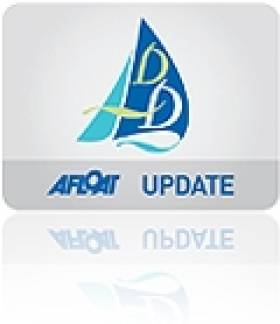Displaying items by tag: National Yacht Club
Topper World Championships 2011 Preview
Over 250 of the world's top youth sailors are expected to partake in the Irish event which will run from August 15th – 19th and promises some of the closest and most exciting youth sailing ever seen on Dublin Bay.
The Topper is one of the world's most popular youth boats with over 50,000 boats around the globe. It has grown greatly in popularity in recent years because it suits the learner sailor as well as those with ambitions of Olympic medals. Because it is exceptionally light and easy to transport, the National Yacht Club is expecting 150 competitors from other countries to partake.
"We are delighted to be hosting the Topper World Championships next August," said National Yacht Club Commodore Peter Ryan. "It will follow on from the Figaro Race stop-over and reflects that fact that Dublin Bay can cater for top class events for both ends of the spectrum. The Topper is an extremely popular boat with young sailors and a great gateway to sailing so we will be putting all the club resources into making the event an outstanding success."
The Topper was designed by Ian Proctor whose other boats include the ever-popular Wayfarer. It was originally constructed in GRP but this was changed quite early on to an injection moulding construction.
After well over 20 years of continuous production it is the outstanding build quality, durability and innovative design features that have made the Topper a very popular boat. The Topper hull is injection moulded with incredible precision, reaching a level of uniformity quite outside the scope of any other production system, either hand-built or mass-produced in GRP or roto-moulded plastic. The material is polypropylene which has proved to combine strength and flexibility with lightness and longevity.
La Solitaire du Figaro 2011 Preview
The race is regarded as one of the world's solo sailing great events and one of the toughest on the international sailing calendar. Although the race has strong connections with Ireland, this is the first time the 42-year-old fixture will visit the island's largest sailing centre.
The fleet will moor in Dun Laoghaire harbour at the finish of the second leg, and will be hosted by the National Yacht Club. Competitors are expected to stay for a week. This year the race visited Kinsale, and in the past has also visited the Irish ports of Crosshaven, Howth and Dingle.
La Solitaire is going back to its roots. Perros-Guirec and Brittany from where the race will start on Sunday, 31st July 2011, are the most faithful of all host ports in the history of the race as Perros-Guirec has hosted a record number, this being the 16th time that the town will welcome the race.
The second French stop-over in 2011 will be Caen, where the race will go back for the third time. The harbour and the village are ideally situated in the city centre and will surely gather thousands of visitors during the week-long stay, with a full schedule of social events organised by the local municipality.
Dieppe will host the finish and close of La Solitaire du Figaro 2011 race. The Haute-Normandie region town expects to see the finish on or around August 24th.
The National Yacht Club is delighted to welcome this prestigious event and will communicate further developments in the very near future.
Preparing for La Solitaire du Figaro here
Latest news for La Solitaire du Figaro hereTen Days of Racing on the South Coast
The ICRA National Championships is being staged at Royal Cork YC from Friday 17th to Sunday 19th June and the Sovereign's Cup at Kinsale YC from Wednesday 22nd to Saturday 25th June.
Dublin boats heading south for these events can race down to the event as part of the Dun Laoghaire to Dingle Race (it's the tenth anniversary race) from the National Yacht Club starting on Saturday, June 11th next.
Entry form for ICRA and Notice of Race available to download below.
La Solitaire du Figaro's Dun Laoghaire Stop-Over
Details for next year's course of the La Solitaire du Figaro race were revealed at the Paris Boat Show yesterday. The race will comprise four French towns and Dun Laoghaire will be the only foreign port of call when the boats are expected to arrive on 10 August.
In spite of Dublin airport weather delays a National YC contingent headed by Commodore Peter Ryan made it to Paris in time for the announcement.
Following several days for rest, the fleet shall once again set sail on 7 August for the second leg, of 470 nautical miles, that will take the Figaro Bénéteau 2 towards Dún Laoghaire. After leaving the Bay of Seine, a 40-mile or so run, the first obstacle will be the passage of the Barfleur point. The course remains inshore, as the single-handed sailors will sail along the Cotentin to the cape of the Hague, before heading towards the Channel Islands.
It will be compulsory to leave the islands of Aurigny, Herm and Guernsey to starboard. The skippers will then take on a long crossing of the English Channel, 120 nautical miles to Land's End. The last third of the course is a sail up almost full north over 190 nautical miles to reach Dún Laoghaire.
The Dublin Bay harbour is set to be a discovery for the visiting sailors and where the National Yacht Club are to be the host venue. After a few days rest and recuperation, the fleet then will set sail on 14 August to The Vendée and Les Sables d'Olonne. This third leg is long at 475 nautical miles with boats expected on 17 August.
Four days later and the final leg departs on 21 August with the boats setting a course for Dieppe, to arrive on 24 August. On the following day the Normandy port will also be hosting a closing regatta. For more information www.lasolitaire.com
Preparing for La Solitaire du Figaro here
Latest news for La Solitaire du Figaro hereMurphy Heading for Australian Regatta
The National Yacht Club's Annalise Murphy (Laser Radial) travelled to Australia last weekend for the Perth International Regatta http://www.perth2011.com/ which starts on the 16th of this month. The aim is to gain valuable experience at the venue which will host the December 2011 ISAF World Championships and which will be a vital qualifying event for the the 2012 London Olympic games.
Also heading for Perth is the Royal St. George's Ben Lynch in the high speed 49er dinghy.
After Perth, Annalise travels to Melbourne for the season's first ISAF World Cup event which will be run from Sandringham Yacht Club from 12-19th December. Annalise is currently ranked 20th Womens Laser Radial sailor and 1st under 21 in the World and is campaigning full time to represent Ireland in the 2012 London Olympic Games.
Top youth Laser Radial Sailor Ross Vaughan from the Royal North of Ireland YC has gone down as a training partner for Annalise together with her coach Rory Fitzpatrick.
Also taking part in the Perth Regatta are Irish 49er team of Ryan Seaton and Matt Mc Govern (Ballyholme YC) and Ross Hamilton from the RIYC, Dun Laoghaire.
Freddie Cooney Remembered
Dun Laoghaire Figaro Visit Plans Public Festival
One of Dun Laoghaire's major international events next season, the visit of the French single-handed fleet, La Solitaire du Figaro, in August, will have a public festival running alongside say the National YC organisers. Dun Laoghaire Harbour Company and Dun Laoghaire Rathdown County Council are behind the festival.
Preparing for La Solitaire du Figaro here
Latest news for La Solitaire du Figaro hereDun Laoghaire Dingle Race Date is June 11, 2011
The 2011 Dun Laoghaire to Dingle Race run jointly by the National Yacht Club and Dingle Boat Club starts on Saturday 11th June with a prize giving on Wednesday 15th in Dingle.
Dun Laoghaire to Participate in 'Open House' Dublin Week
Several waterfront buildings in Dun Laoghaire Harbour will be made open to the public on Sunday 10 October as part of 'Open House' Dublin Week (7th-10th October). With over 150 tours and workshops, the free event is Ireland's biggest architecture festival, allowing citizens to explore the architecture of their city. Buildings of all types and periods will open up in an event programme which is organised into areas.
In Dun Laoghaire-Rathdown the following buildings below are all open on Sunday 10 October. NOTE: There are other buildings throughout the borough also open to the public for free admission, for information on contact details see bottom of this page.
Commissioners of Irish Lights (CIL), Harbour Road. Tours provide a fascinating insight into the headquarters and work of the Commissioners of Irish Lights. Sunday 10 October (12–5pm). Last tour at 4.30pm. Regular tours. First-come basis. Disabled access.
Harbour Lodge (HQ of Dún Laoghaire Harbour Company), Crofton Road. Built in the neo-classical style, the Georgian house represents the first serious piece of architecture in the town. Sunday 10 October (12–5pm). Last tour at 4.30pm. Regular tours. First-come basis. Disabled access.
Dún Laoghaire-Rathdown County Hall, Marine Road. The council's premises have evolved to comprise the original Town Hall, the adjoining 19th century post office and a late 20th century extension. Sunday 10 October (12-5pm) Last tour at 4.30pm. Regular tours. First-come basis. Disabled access.
(Tour includes the recent Old Town Hall refurbishment by DLRCC Architects Department).
Royal St George Yacht Club, Harbour Road. Founded in 1838, the historic building has been extended with a very contemporary addition. Clad in distinctive copper, this extension is connected to the original club by a glass-covered atrium. Sunday 10 October (12–5pm). Last tour at 4.30pm. Regular tours. First-come basis. Disabled access.
National Yacht Club, Harbour Road. A magnificant Class A listed building which has a design hybrid between a French château and an 18th-century country garden pavilion. Sunday 10 October (2–5pm). Last tour at 4.30pm. Regular tours. First-come basis. Disabled access.
Like most of the tours and events in Open House Dublin, there is no pre-booking required. Entry is FREE and on a first-come basis. For more information about what to expect from your tour or event. Contact: Open House Info Desk Tel: (01) 6165220 and check 'How It Works' by logging onto www.architecturefoundation.ie/openhouse/
SB3s Plan Further Expansion with Dun Laoghaire Open Day
New sailors are invited to try a sail on the 'one design performance boat' in a special Open Day on Saturday, 9th October between 1030 and 1600. Registration begins at 9.30am.
Boats will be alongside at the National Yacht Club in the harbour for demo runs and class members will be available to discuss the Sportsboat design.
The recent SB3 Nationals staged in Howth this month attracted a fleet of 48 boats racing with attendance from all the major Irish sailing centres. Internationally Ireland sends a team to the World championships and the inaugural world championships were held here in Dun Laoghaire in 2008 with a massive fleet of 137 boats.
The class association will organising sailing in Scotsman's Bay on October 9th with RIB transfers to the boats. Experienced or novice sailors are all invited to participate. Those wishing to sail ideally should advise the organisers first of their time slots and make sure they bring their sailing wet weather gear and a life jacket. Short races will also be run to allow visitors get a feel of the boats.
To make a provisional booking, please call or text Justin on 087 2417542





































































